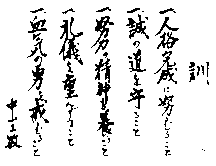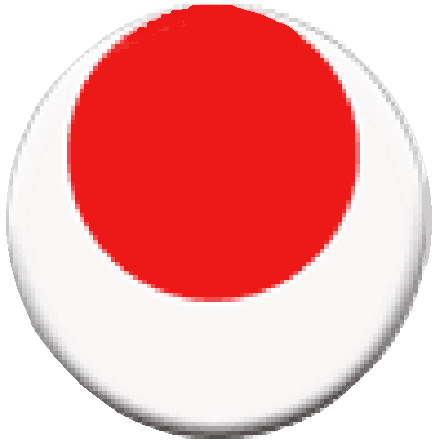|
| |
| Karate Training
reflects tradition and embodies the etiquette to be followed by the practictioner. Traditional karate-do
of the Japan Karate Association India Branch exemplifies the tradition followed in JKA Dojos world wide. The Term Doujou commonly
spelt as dojo literally means place of training the way and is actually
two charectars
in Japanese Dou and jou |
 |
Dou or way also known as michi or road. When used with the martial art of karate,
it denotes the
path taken by the practictioner in following the precepts of karate, hence the term karate-dou or
commonly written as karate-do |
 |
Jou or place. Usually connected with learning. When defined within the frame work
of Karate-do,
the term becomes a training place. In the martial arts especially the two words are usually combined and the Dou-jou
becomes the place where you practice your way. |
| The
dojo has four sides each of which commands a different level of respect. The Front
or Shoumen is the
highest. This side is normally where the Altar or the shrine of the dojo is present
and the flag of the country is found. The second level of respect is to the right side where the seniors
of the dojo line up. The third level is the left and the last is the rear. |
| Upon entering the Dojo |
 |
Training in the Karate
dojo is bare foot, hence before entering the dojo, please make sure that you are barefoot. Upon
entering the dojo, first pay respect to the dojo by bowing from the waist. Keep
the back
straight while bowing, simultaenously uttering the traditional karate greetingof Oss,or Osu, or Ossu all these are used. Many
articles have been written on this term which dates
back to the days of the ssamurai warriors. However most Japanese believe that
it is a short form for the term Onegaishimasu or favour me. |
| Cleaning the Dojo |
| It is very important to remember
that the dojo is the place where you learn the way of karate. Hencemake sure that your feet are
clean when you step into the dojo so that you do not dirty the dojo. In case the dojo needs cleaning, do not
hesitate to participate in the cleaning of the dojo regardless of yourrank.Your Dojo must always be clean.
Do not delegate the job to a junior. Be proud of your dojo as itreflects the attitude of the students and teacher.
The spiritual aspect, apart, it is important to remember that unless the floor is clean your
feet & dogi will get dirty. In Japan, the dojos have wooden flooring which are spotless. In India most
dojos have concrete floors where the cleanling is much easier. This is one task that teaches
you humility.Your Juniors seeing you do this will also learn the traits of humility. It is also another form
of exercise before begining the class. |
| Lining
up in the Dojo | | |  | After
ensuring that the dojo is clean, the command to line up is given.in Japanese command is seiretsu
The class lines up as follows: senior
grade student on the extreme right line with the senior
most student standing first in line.The lines to the
immediate left of the first line would be those of the next level with the beginners
in
on the extreme left line. Ensure enough distance between the lines in line with
the
person on the extreme right line.When the Sensei or the Class instructor stands
in front
of the class ready to begin the dojo the Japanese command of ki o tsuke
or
attention to is given by the senior most student. At which everybody
ensures that
the lines are straight and everybody is in position. The stance normally taken
is
that of Musubu -Dachi or the formal attention stance. |
| seiretsu | ki
otsuke |
| Sitting in the Dojo |
| |
After
ensuring that the command ki o tsuke is fobeyed the Japanese command of seiza
or to be seated
in the Japanese manner to is given by the senior most student.who is normally the first person in the extreme right
line. From theMusubi Dachi position, take your
right leg back bend it and kneel with the toes bent forward the heel pointing
upwards. Next take your left
leg back, kneeling and bring your buttocks to rest on the upward pointing heels. Rest on this for
a brief second or two then raise your hips to take
your feet back so that the instep and toes lie flat against the floor. Rest your
hips once
again on the upturned soles of your feet & bring your right big toe over the
left one.
Keep your back absolutely erect. Chin tucked in and eyes looking straight in front.Calm
yourmind by concentrating
on your breathing and on the part just below your navel. |
seiza |
| Meditation while seated in seiza
in the Dojo | | |
The
senior most in the class gives the command of Mokusou at which the students and teacher alike close their eyes for a brief period of mediatation
and prayer. The term
has arisen
from the sanskrit word of moksha or liberation, normally in connection with the
soul and the
buddhist connotation of the
term is associated with the concept liberating one
self from all
attachments or desires. However in the dojou, the term is used to ensure the emptying
of the mind
from various other thoughts. When taken in the context of training, this period is for
the student to calm the mind and detach oneself from the
outside world while preparing oneself for the training ahead. Upon the senior giving the command
of mokusou
naore or mokusou yame, the class
opens it eyes. |
| Mokusou |
| Paying respect or
obience while seated in seiza in the Dojo | |
| 
|
After the mokusu naore command, the senior then asks the class to pay it's respect
to the Shrine
if there is one or to the front of the dojo, then to the instructor and to each
other Paying obience to the Shrine of
the dojo if there is one in the class which
signifies the enshrinement of the spirits of the various masters through the
ages who have taught this art. In
the absence of the Shrine, the class pays obience to the front of the dojo which
has the flags of the country and the dojo . The front wall normally also
would have the portrait of Dai Sensei Funakoshi Gichin. The
whole class pays obeince to either the altar or the front. At this time, it is a silent bow from the waist both hands palm down
moving simultaenously towards the floor. the palms
are turned slightly inwards. After the
whole class pays obeince to either the altar or the front., the teacher or Sensei turns around and the senior of the class utters the phrase Sensei
ni rei upon which the class bows to the teacher, Bow from the waist both hands palm down
moving towards the floor. the palms
are turned slightly inwards while simultaenously uttering the traditional karate greetingof Oss,or Osu, or Ossu. The teacher returns the greeting The whole class bows to one another. Karate-do treaches the student the concept of courtesy. This bow is done both at the start of the session as well as at the end of the session |
| Shinzen
ni rei |  |
| REI |
Shoumen ni rei |
|
Sensei
ni rei |
|
|
| |
| The Calligraphic Characters
(kanji) for Dojo kun |
| A
Karate dojo has certain precepts, based on which the karate students' character
and manner of interaction with the world at large is molded. These precepts are
a part of the daily ritual in a traditional karate dojo. Every
dojo ends with the Sensei making the karatekas repeat the following Dojo Precepts
based on the clear understanding of the Karate-do ideals of character building.
The original Dojo kun were made by a Karate teacher from Okinawa by the name of
Sakugawa Shungo who based them on the Chinese training hall rules prevalent at
the time of Boddhidharma. |
 |
The JKA Dojo Kun in the illustration
has the signature on the extreme left of Sensei Masatoshi Nakayama, the late Chief
Instructor of the JKA. |
| Given
below are the dojo kun with each of the 5 precepts listed separately. The Japanese
Lines are reproduced in Kanji, (Calligraphic Chinese Characters) with the
pronunciation of the same line in English. The English Translation of the line
is given separately. |
 | Hitotsu,
jinkaku kansei ni tsutomeru koto | one,
to work toward completeness in one's character viz. Seek
perfection of personality |  | Hitotsu, makoto no michi wo mamoru koto. | One,
to defend the path of truth viz. to stick to the truth regardless of the consequences.
|  | Hitotsu
, doryoku no seishin wo yashinau koto. | One,
to foster a spirit of hard work. viz. to cultivate the spirit of putting in effort
|  | Hitotsu,
reigi wo omonzuru koto. | One,
to keep in esteem the factors of courtesy and respect viz. to respect others |
 | Hitotsu,
kekki no yu wo imashimuru koto. | One,
to guard against the urge of being driven by physical youthful passion. viz.
dont be impetuous / violent | |
|








